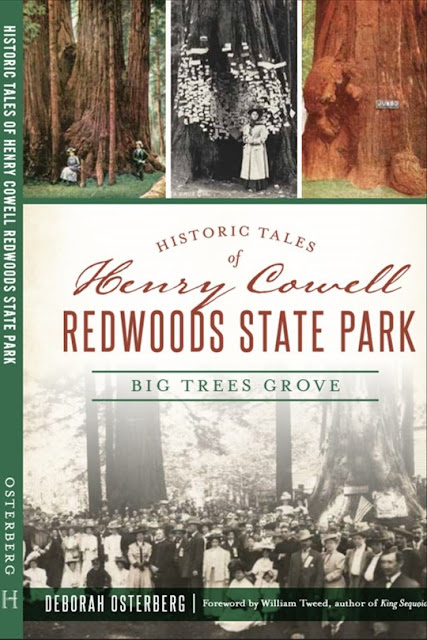In light of the CZU Fire which recently devastated a portion of our beloved Santa Cruz Mountains, I offer the following excerpt which described a fire which swept through San Lorenzo Canyon on September 22, 1913.
The fire described below threatened the first redwood resort known as Welch's Big Trees Grove (1867-1930).
The 1913 fire also endangered the neighboring resort, Cowell's Big Trees (Hopkins' Club House). The locations of both old resorts are now part of our beloved Henry Cowell Redwoods State Park in Felton.
As we mourn the damage wrought upon our sister park, Big Basin (closed to the public for the foreseeable future), we find solace in the work of dedicated fire fighters (neighbors and professionals) who ensured that the CZU fire did not sweep down Ben Lomond Mountain to all the communities of the San Lorenzo Valley and Felton's historic grove of Big Trees.
This excerpt shows how earlier fire fighters accomplished a similar feat.
September 22, 1913 - "A forest fire this afternoon threatened the
famous Felton and Cowell big tree groves in which General Fremont once camped
in the days before the bear flag was raised and at half past three was within
100 yards of the steel trestle at the southern end of the grove."
"The fire started at the rear of Mount Hermon, a
third of a mile from Felton Station. It burned a few pines and brush on the
outer edge of the Mount Hermon association property and then, crossed the
Graham Hill road to Pine Flat* a sandy section of the country, covered with
magnificent pine trees. It then swept along the ridge into the redwoods and
pines of Stanley Welch and to the Henry Cowell Lime and Cement Co property
where it burned fiercely amongst redwoods, pines, madrone, manzanita … and
underbrush and covered a stretch of country three miles long and from a half to
a mile wide."
"The Southern Pacific, the [C]owell’s and Welch’s
within a few hours had over 200 men at work fighting fire. The Southern Pacific
got 25 section hands at Watsonville Junction and 25 more between there and
Santa Cruz. There were taken up on the 1:30 a.m. train and soon were using the
wood roads for the building of fire trails and for backfiring."
"At noon the raging flames were within 500 yards
of the big trees and the people in the grove were playing the hose on the
building as it was then believed there was no hope from keeping the blaze from
these monarchs of the woods, but the wind suddenly shifted and the course was
changed southward down San Lorenzo canyon. There was another change in the
afternoon about three and the fire went back and was within 100 yards of the
grove, but by backfiring the flames were kept from further approaching."
"The passengers on the 1:35 p.m. train had a
great sight as the train approached the grove. The hillside at different spots
were masses of flame. The fire would leap from tree to tree then spread over a
high fir or redwood with flames shooting 200 feet in the air."
"The greatest loss was to the Cowell Co as they had thousands of cords of wood cut on their land and they had big crews of men who were at work staying the work of [destruction]. Fire three times before in the last 20 years has visited this section but never has it been so close to the big tree grove. The clouds of smoke could be seen from Santa Cruz and caused much excitement. For a long time two fires were burning[,] one near the big trees and the other on the Pine Flat on the Graham Hill road. The fire was wonderfully spectacular with the roaring and the tongues of fire"
This article further notes that Cowell's Big Trees' resort proprietor, Milo Hopkins, furnished the 1913 fire fighters with "sandwiches and liquid refreshments." Amazingly, Henry Cowell Redwoods State Park served in this same capacity once again. This time serving as a base camp to feed the hero fire-fighters of the CZU Fire.
Happily the main section of Henry Cowell Redwoods State Park is once again open to the public. Please note that the Fall Creek unit of the park, which suffered significant fire damage, is closed until further notice.
The last fire which swept through the heart of Big Trees Grove came in 1867. It is reassuring for us today to know that the redwoods are remarkable survivors and have recovered from many fires in the past.** Because of the CZU Fire, Henry Cowell (open to the public) and Big Basin (currently closed) are now living classrooms to show us two very different stages in the life of a redwood forest.
At Henry Cowell Redwoods State Park, a stroll along the Redwood Loop Trail (.9 mile) takes you through the site of the historic resort. Though none of the resort's historic structures remain, you will see the magnificent Big Trees which enthralled thousands of visitors for the past 150 years.
My book, Historic Tales of Henry Cowell Redwoods State Park - Big Trees Grove, allows you to enjoy numerous historic images and learn the ground-breaking history of Big Trees Grove, the first redwood resort, and how it inspired the preservation of the redwoods.
Source: “Forest Fire Threatens Big Trees,” San Jose Mercury-News, Volume LXXXV, Number 85, 23 September 1913.









